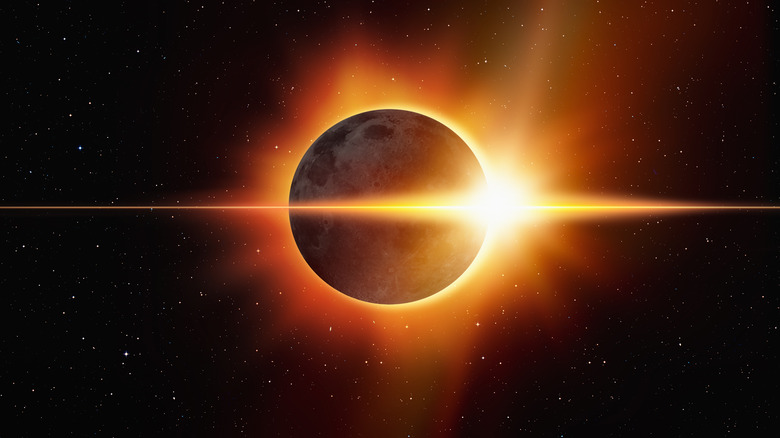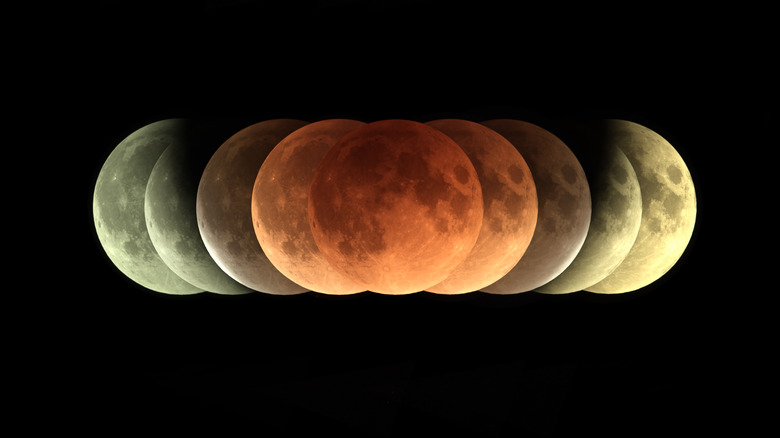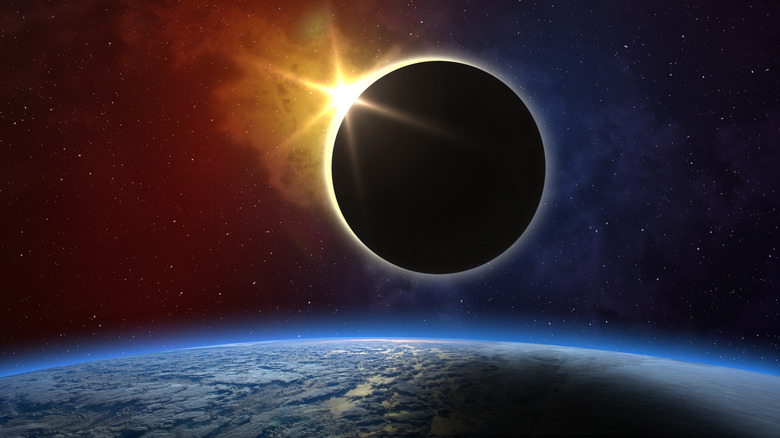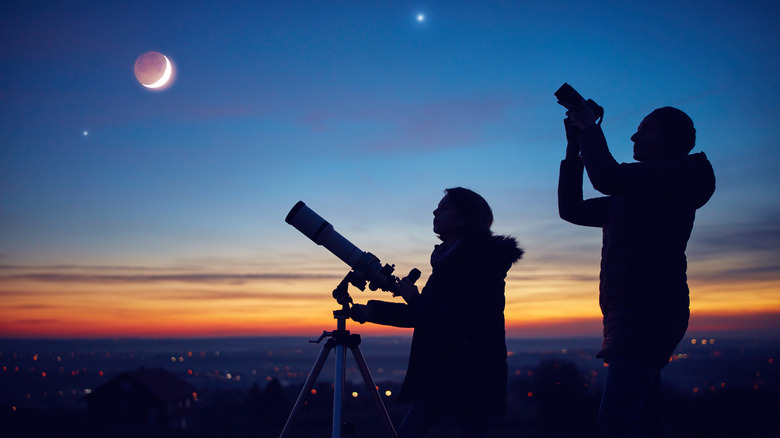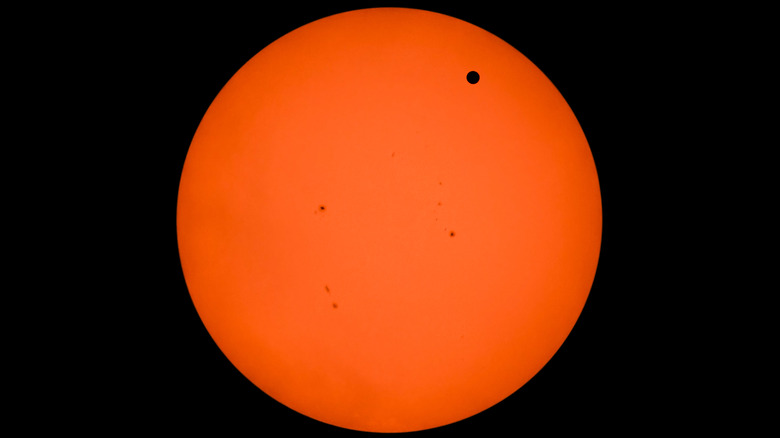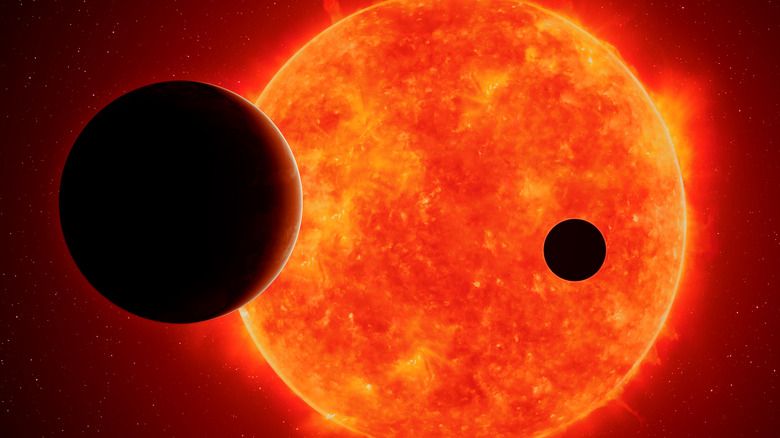What Is The Difference Between Transits And An Eclipse?
When it comes to phenomena that can be seen in the sky, none is quite as impressive as that of a solar or lunar eclipse. Transits and eclipses are rare, and some are even once-in-a-lifetime events. According to StarDate, an eclipse occurs when a celestial body (such as the moon) partially or fully masks another celestial body (like the sun) from an observer's (the Earth's) point of view.
While you've probably heard of an eclipse before and maybe even seen one, you may not know what a transit it. Just like an eclipse, a transit takes place when a celestial body crosses in front of another celestial body from an observer's point of view. "But in a transit, the apparent size of the first object is not large enough to cast the second into complete shadow," NASA writes. From Earth's point of view, transits of the sun are incredibly rare, but they play an important part in the hunt for exoplanets orbiting other stars.
There are different kinds of eclipses
In addition to the differences between eclipses and transits, there are several types of each. From Earth, we can see solar and lunar eclipses thanks to the alignment of our moon and the sun. According to NASA, a lunar eclipse occurs when the Earth's shadow blocks the sun's light from hitting the moon, turning it red. A solar eclipse is the opposite, taking place when the moon blocks the sun's light from hitting us.
Interestingly, there are also several types of solar eclipses. Solar eclipses can be classified as either total, partial, or annual. The type of eclipse that takes place depends on the distance between the moon and Earth, which varies slightly throughout the year (via Britannica). A total eclipse occurs when the moon blocks the entirety of the sun, and a partial eclipse occurs when it only blocks a portion of the sun. According to Time and Date, an annual eclipse happens when the moon is in the right position for a total eclipse but is too far from Earth to actually cover the entirety of the sun, leaving a ring of the sun's light visible.
Eclipses are more common than transits
While eclipses are often thought of as incredibly rare events, they are more common than you might think. According to Britannica, solar eclipses occur between two and five times a year, while lunar eclipses usually take place twice a year, although that number can vary. Even total solar eclipses aren't as rare as they seem, taking place every 18 months on average (via the Natural History Museum). Many people assume eclipses are few and far between because, despite their frequency, it is uncommon for them to be visible in the same areas more than once every few years.
Eclipses may be common, but transits are harder to come by. Transits of Mercury are the most common that are visible from Earth but only take place once every seven years (via NASA). Meanwhile, transits of Venus take place in pairs, with two transits occurring eight years apart. After a pair of Venus transits happen, the next pair won't be visible for another 243 years (via The Planetary Society).
Transits are only visible with proper equipment
While solar and lunar eclipses can be seen by just looking up (although you should never look directly at the sun without special safety glasses), transits require a telescope or binoculars in order to be seen. It is important to note that the lens inside your telescope or binoculars should never be pointed at the sun without a solar filter. Just like a magnifying glass, these lenses concentrate the sun's light and can set things on fire and cause permanent damage to your eyes (via Scientific American).
If you want to look at an eclipse or transit using a telescope or binoculars, you must use a special solar filter. According to Sky & Telescope, you should chose a solar filter designed by the maker of your scope to ensure it fits properly. These filters are relatively inexpensive and allow you to view a transit or eclipse without worrying about eye damage. They also keep your telescope's or binoculars' sensitive equipment from becoming damaged, making it a worthwhile investment if you plan to use a scope to view the sun (via the American Astronomical Society).
From Earth, we can only see transits of Mercury and Venus
As stated earlier, a transit is an apparent crossing of an object from a viewers point of view. In our case, this is any planet crossing the sun from Earth's view (via NASA). As long as we are here on Earth, we can only see transits of planets that cross between us and the sun. Since Earth is the third planet from the sun, we can only witness transits of Mercury and Venus, as they are the only two planets with shorter orbits than Earth, according to Space.com.
While we can only watch a transit of Mercury or Venus of the sun from Earth, future astronomers on other planets or space probes could witness the transits of other planets, including Earth. In fact, transits of exoplanets around their host stars can even be detected, allowing astrophysicists to find new exoplanets every day (via NASA).
Exoplanets can be discovered when they transits their stars
While transits of planets in our solar system may not sound exciting to non-astronomers, they are important for finding exoplanets. According to NASA, nearly 4,000 of the 5,000 known exoplanets have been found using an exoplanet method known as the transit method. This method utilizes transits of exoplanets across their host stars in order to confirm their existence.
Most stars are so bright that their exoplanets cannot be seen next to their brilliant light. The transit method of exoplanet hunting allows astronomers to find exoplanets by detecting the dips in a star's brightness that occur when one of its planets crosses in front of it from our perspective, blocking out a fraction of starlight for a temporary period of time (via the Institute for Research on Exoplanets). Without being able to detect exoplanet transits, the number of known exoplanets would be much lower, and our understanding of the universe would differ from reality.
